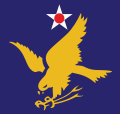502nd Fighter-Bomber Squadron
| 502nd Fighter-Bomber Squadron | |
|---|---|
 P-40 Warhawks as flown by the squadron | |
| Active | 1942–1944 |
| Country | |
| Branch | |
| Role | Fighter-bomber training |
| Insignia | |
| 502nd Fighter-Bomber Squadron emblem[a][1] |  |
The 502nd Fighter-Bomber Squadron is an inactive United States Air Force unit. It was assigned to the 85th Fighter-Bomber Group. It participated with dive bombers in air support maneuvers until 1943, when it became a Replacement Training Unit for fighter-bomber pilots. It was disbanded on 1 May 1944, when the Army Air Forces reorganized its training and support units in the United States.
History
[edit]
The squadron was activated in February 1942 as the 308th Bombardment Squadron at Savannah Army Air Base, Georgia, one of the four squadrons of the 85th Bombardment Group. It moved to Bowman Field, Kentucky, where it was equipped with Vultee V-72 Vengeance[b] aircraft and began training for air support missions. However, the Army Air Forces (AAF) determined that the Vengeance was not suited as a dive bomber.[2] In August the squadron moved to Waycross Army Air Field, Georgia, where it began to receive Douglas A-24 Banshees.[3]
In November 1942, the squadron moved to Blythe Army Air Base, California,[1] where it participated in air-ground maneuvers as part of the Desert Training Center, and replaced its Banshees with North American A-36 Apaches in December.[1][3] In April 1943, it moved to Harding Army Air Field, Louisiana, where it served as a Replacement Training Unit (RTU), flying Bell P-39 Airacobras and Curtiss P-40 Warhawks.[1] RTUs were oversized units that trained individual pilots or aircrews.[4] By early December, it moved to Punta Gorda Army Air Field, Florida, where it concentrated on training with P-40s and was attached to the 337th Fighter Group, which was located at Sarasota Army Air Field, Florida.[1][5]
However, the AAF found that standard military units like the 502nd, Whose manning was based on relatively inflexible tables of organization, were proving not well adapted to the training mission. Accordingly, it adopted a more functional system in which each base was organized into a separate numbered unit, with flexible manning.[6] The 502nd was disbanded on 1 May 1944,[1] and transferred its personnel and equipment to the 344th AAF Base Unit (Replacement Training Unit, Fighter).[7]
Lineage
[edit]- Constituted as the 308th Bombardment Squadron (Light) on 13 January 1942
- Activated on 10 February 1942
- Redesignated 308th Bombardment Squadron (Dive) on 27 July 1942
- Redesignated 502nd Fighter-Bomber Squadron on 10 August 1943
- Disbanded on 1 May 1944[1]
Assignments
[edit]- 85th Bombardment Group (later 85th Fighter-Bomber Group), 10 February 1942 – 1 May 1944 (attached to 337th Fighter Group after 3 December 1943)[1]
Stations
[edit]- Army Air Base, Savannah, Georgia, 10 February 1942
- Bowman Field, Kentucky, 16 February 1942
- Hunter Field, Georgia, 9 June 1942
- Waycross Army Air Field, Georgia, 15 August 1942
- Gillespie Field, Tennessee, 3 October 1942
- Blythe Army Air Base, California, 2 November 1942
- Rice Army Air Field, California, 21 January 1943
- Harding Army Air Field, Louisiana, 9 April 1943
- Waycross Army Air Field, Georgia, 26 August 1943
- Punta Gorda Army Air Field, Florida, 3 December 1943 – 1 May 1944[1]
Aircraft
[edit]- Vultee V-72 Vengeance, 1942
- Douglas A-24 Dauntless, 1942–1943
- North American A-36 Apache, 1943
- Bell P-39 Airacobra, 1943–1944
- Curtiss P-40 Warhawk, 1944[1]
Campaign
[edit]| Campaign Streamer | Campaign | Dates | Notes |
|---|---|---|---|
| American Theater without inscription | 10 February 1942–1 May 1944 | 308th Bombardment Squadron (later 502nd Fighter-Bomber Squadron)[1] |
References
[edit]Notes
[edit]- Explanatory notes
- ^ Approved 10 October 1942. Description: On a disc yellow, a caricatured figure in flight uniform tan, wearing helmet and goggles, astride the fuselage of a dive bomber brown, feet braced against trailing edge of wings, grasping and throwing an aerial bomb blue with right hand; aircraft and figure all diving bendsinisterwise, and emitting speed lines white.
- ^ An export version of the A-31, commandeered from a British order.
- Citations
- ^ a b c d e f g h i j k Maurer, Combat Squadrons, pp. 605-06
- ^ See "Abstract, History 84 Fighter-Bomber Group to Jul 1943". Air Force History Index. Retrieved 22 May 2012.
- ^ a b No byline. "Abstract, History 85th Fighter-Bomber Group, CY 1942". Air Force History Index. Retrieved 28 June 2025.
- ^ Craven & Cate, Introduction, p. xxxvi
- ^ Maurer, Combat Units, pp. 215-16
- ^ Goss, p. 75
- ^ No byline. "Abstract, History Punta Gorda AAF, Sep 1943-Apr 1944". Air Force History Index. Retrieved 30 June 2025.
Bibliography
[edit]![]() This article incorporates public domain material from the Air Force Historical Research Agency
This article incorporates public domain material from the Air Force Historical Research Agency
- Craven, Wesley F.; Cate, James L., eds. (1955). The Army Air Forces in World War II (PDF). Vol. VI, Men & Planes. Chicago, IL: University of Chicago Press. LCCN 48003657. OCLC 704158. Retrieved 17 December 2016.
- Goss, William A. (1955). "The Organization and its Responsibilities, Chapter 2 The AAF". In Craven, Wesley F.; Cate, James L. (eds.). The Army Air Forces in World War II (PDF). Vol. VI, Men & Planes. Chicago, IL: University of Chicago Press. LCCN 48003657. OCLC 704158. Retrieved 17 December 2016.
- Maurer, Maurer, ed. (1983) [1961]. Air Force Combat Units of World War II (PDF) (reprint ed.). Washington, DC: Office of Air Force History. ISBN 0-912799-02-1. LCCN 61060979. Archived from the original (PDF) on 15 January 2021. Retrieved 17 December 2016.
- Maurer, Maurer, ed. (1982) [1969]. Combat Squadrons of the Air Force, World War II (PDF) (reprint ed.). Washington, DC: Office of Air Force History. ISBN 0-405-12194-6. LCCN 70605402. OCLC 72556. Archived from the original (PDF) on 20 December 2016.


